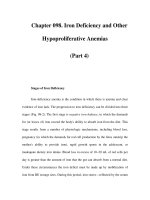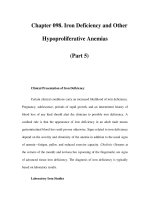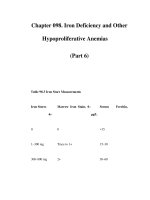Chapter 098. Iron Deficiency and Other Hypoproliferative Anemias (Part 11) pps
Bạn đang xem bản rút gọn của tài liệu. Xem và tải ngay bản đầy đủ của tài liệu tại đây (14.21 KB, 6 trang )
Chapter 098. Iron Deficiency and Other
Hypoproliferative Anemias
(Part 11)
Protein Starvation
Decreased dietary intake of protein may lead to mild to moderate
hypoproliferative anemia; this form of anemia may be prevalent in the elderly. The
anemia can be more severe in patients with a greater degree of starvation. In
marasmus, where patients are both protein- and calorie-deficient, the release of
EPO is impaired in proportion to the reduction in metabolic rate; however, the
degree of anemia may be masked by volume depletion and becomes apparent after
refeeding. Deficiencies in other nutrients (iron, folate) may also complicate the
clinical picture but may not be apparent at diagnosis. Changes in the erythrocyte
indices on refeeding should prompt evaluation of iron, folate, and B
12
status.
Anemia in Liver Disease
A mild hypoproliferative anemia may develop in patients with chronic liver
disease from nearly any cause. The peripheral blood smear may show spur cells
and stomatocytes from the accumulation of excess cholesterol in the membrane
from a deficiency of lecithin cholesterol acyltransferase. Red cell survival is
shortened, and the production of EPO is inadequate to compensate. In alcoholic
liver disease, nutritional deficiencies are common and complicate the
management. Folate deficiency from inadequate intake, as well as iron deficiency
from blood loss and inadequate intake, can alter the red cell indices.
Hypoproliferative Anemias: Treatment
Many patients with hypoproliferative anemias experience recovery of
normal hemoglobin levels when the underlying disease is appropriately treated.
For those in whom such reversals are not possible—such as patients with end-
stage kidney disease, cancer, and chronic inflammatory diseases—symptomatic
anemia requires treatment. The two major forms of treatment are transfusions and
EPO.
Transfusions
Thresholds for transfusion should be altered based on the patient's
symptoms. In general, patients without serious underlying cardiovascular or
pulmonary disease can tolerate hemoglobin levels above 8 g/dL and do not require
intervention until the hemoglobin falls below that level. Patients with more
physiologic compromise may need to have their hemoglobin levels kept above 11
g/dL. A typical unit of packed red cells increases the hemoglobin level by 1 g/dL.
Transfusions are associated with certain infectious risks (Chap. 107), and chronic
transfusions can produce iron overload. Importantly, the liberal use of blood has
been associated with increased morbidity and mortality, particularly in the
intensive care setting. Therefore, in the absence of documented tissue hypoxia, a
conservative approach to the use of red cell transfusions is preferable.
Erythropoietin (Epo)
EPO is particularly useful in anemias in which endogenous EPO levels are
inappropriately low, such as the hypoproliferative anemias. Iron status must be
evaluated and iron repleted to obtain optimal effects from EPO. In patients with
chronic renal failure, the usual dose of EPO is 50–150 U/kg three times a week
intravenously. Hemoglobin levels of 10–12 g/dL are usually reached within 4–6
weeks if iron levels are adequate; 90% of these patients respond. Once a target
hemoglobin level is achieved, the EPO dose can be decreased. A fall in
hemoglobin level occurring in the face of EPO therapy usually signifies the
development of an infection or iron depletion. Aluminum toxicity and
hyperparathyroidism can also compromise the EPO response. When an infection
intervenes, it is best to interrupt the EPO therapy and rely on transfusion to correct
the anemia until the infection is adequately treated. The dose needed to correct the
anemia in patients with cancer is higher, up to 300 U/kg three times a week, and
only about 60% of patients respond.
Longer-acting preparations of EPO can reduce the frequency of injections.
Darbepoetin alfa, a molecularly modified EPO with additional carbohydrate, has a
half-life in the circulation that is 3–4 times longer than epoetin alfa, permitting
weekly or every other week dosing.
Acknowledgment
Dr. Robert S. Hillman was the author of this chapter in the 14th edition, and
material from his chapter has been retained
Further Readings
Bailie GR et al: Parenteral iron use in the management of anemia in end-
stage renal disease patients. Am J Kidney Dis 35:1, 2000 [PMID: 10620537]
Brugnara C: Iron deficiency and erythropoiesis: New diagnostic
approaches. Clin Chem 49:1573, 2003 [PMID: 14500582]
Fleming RE, Bacon BR: Orchestration of iron homeostasis. N Engl J Med
352:1741, 2005 [PMID: 15858181]
Ganz
T: Hepcidin, a key regulator of iron metabolism and mediator of
inflammation. Blood 102:783, 2003 [PMID: 12663437]
Hillman RS et al: Hematology in Clinical Practice,
4th ed. New York,
McGraw-Hill, 2005
Stoltzfus RF: Iron deficiency: Global prevalence a
nd consequences. Food
Nutr Bull 24(Suppl 4):S99, 2003
Thomas C et al: The diagnostic plot: A concept for identifying different
states of iron deficiency and monitoring the response to epoetin therapy. Med
Oncol 23:23, 2006 [PMID: 16645227]









